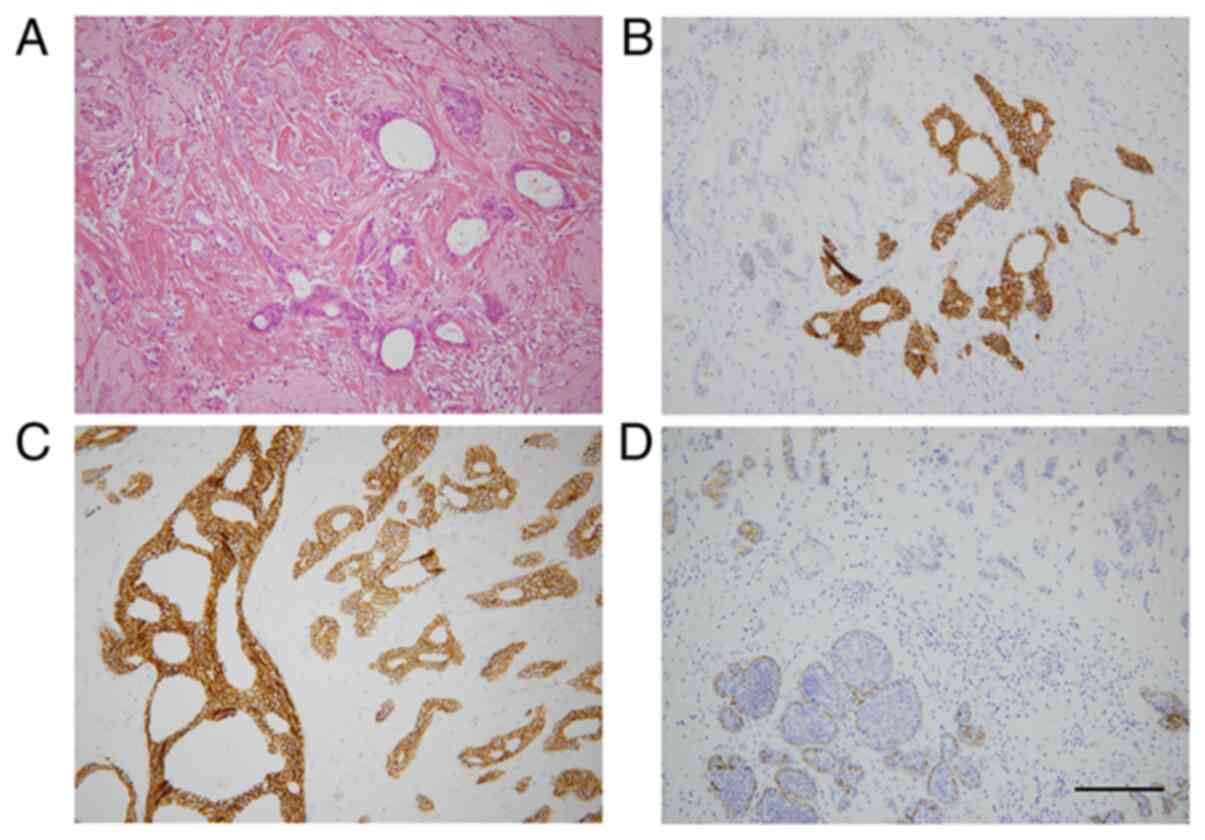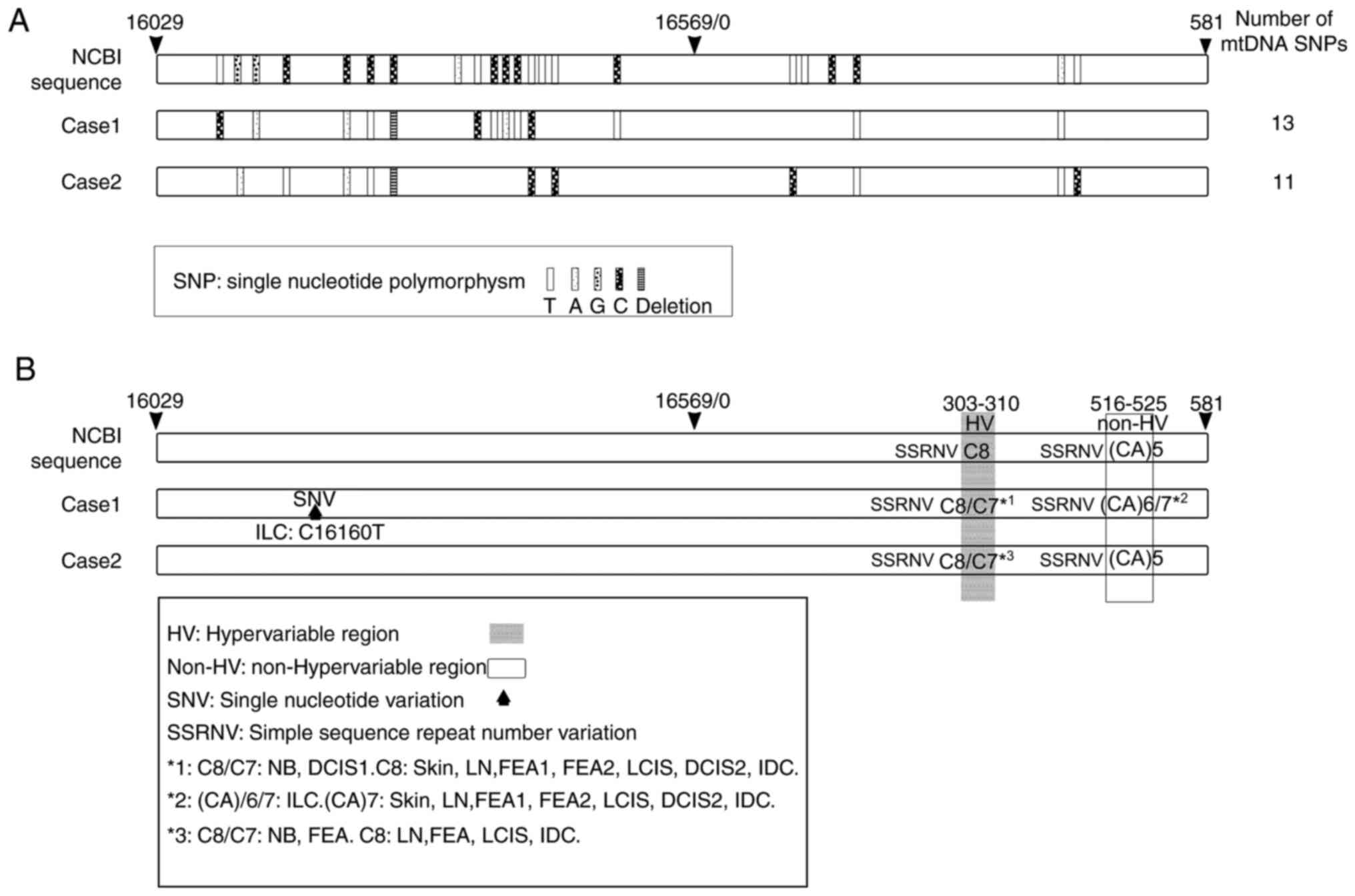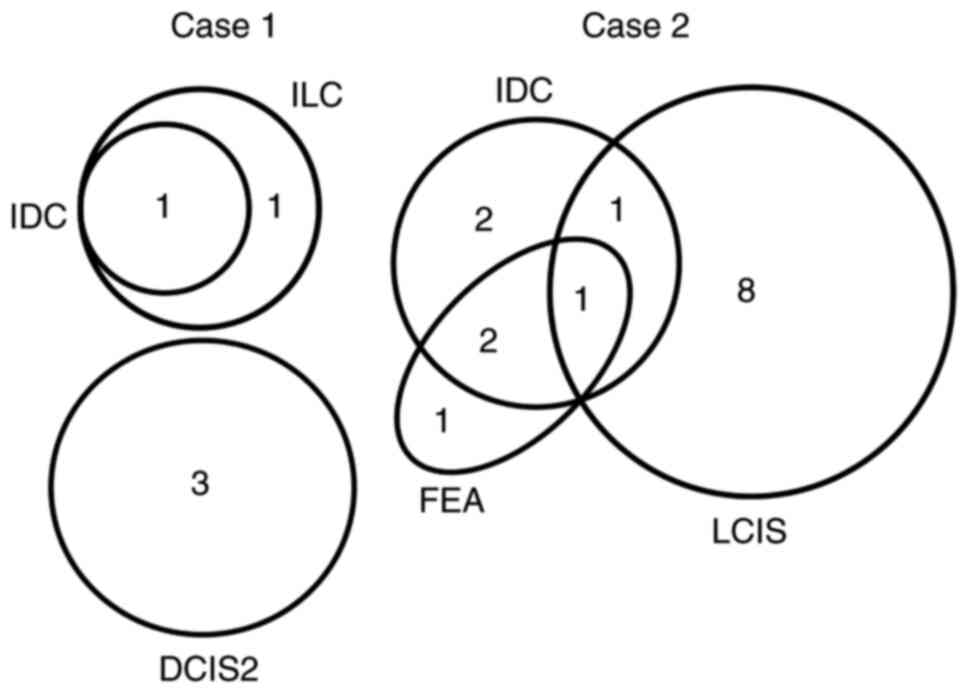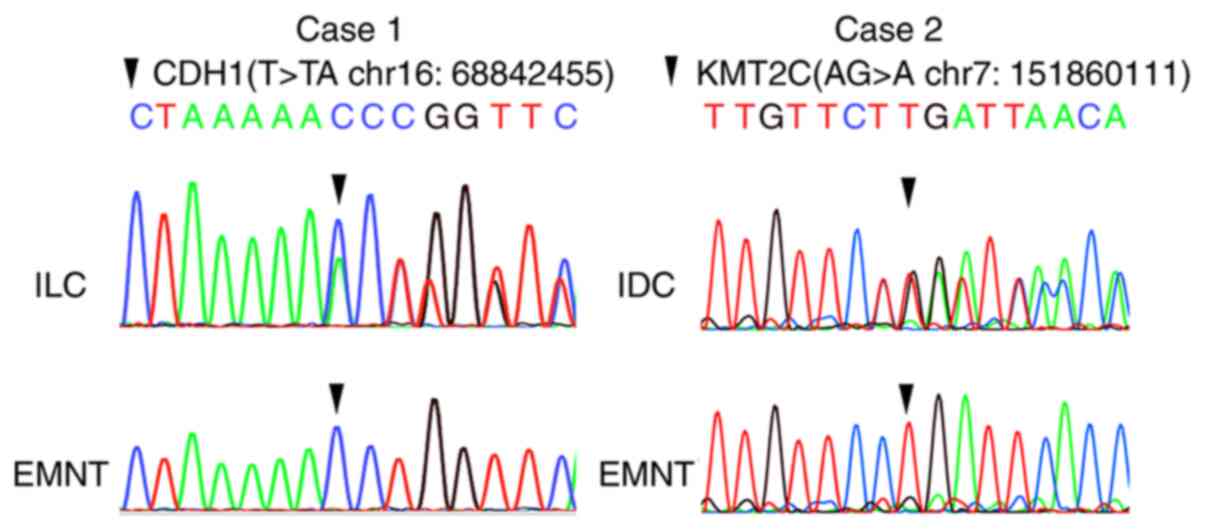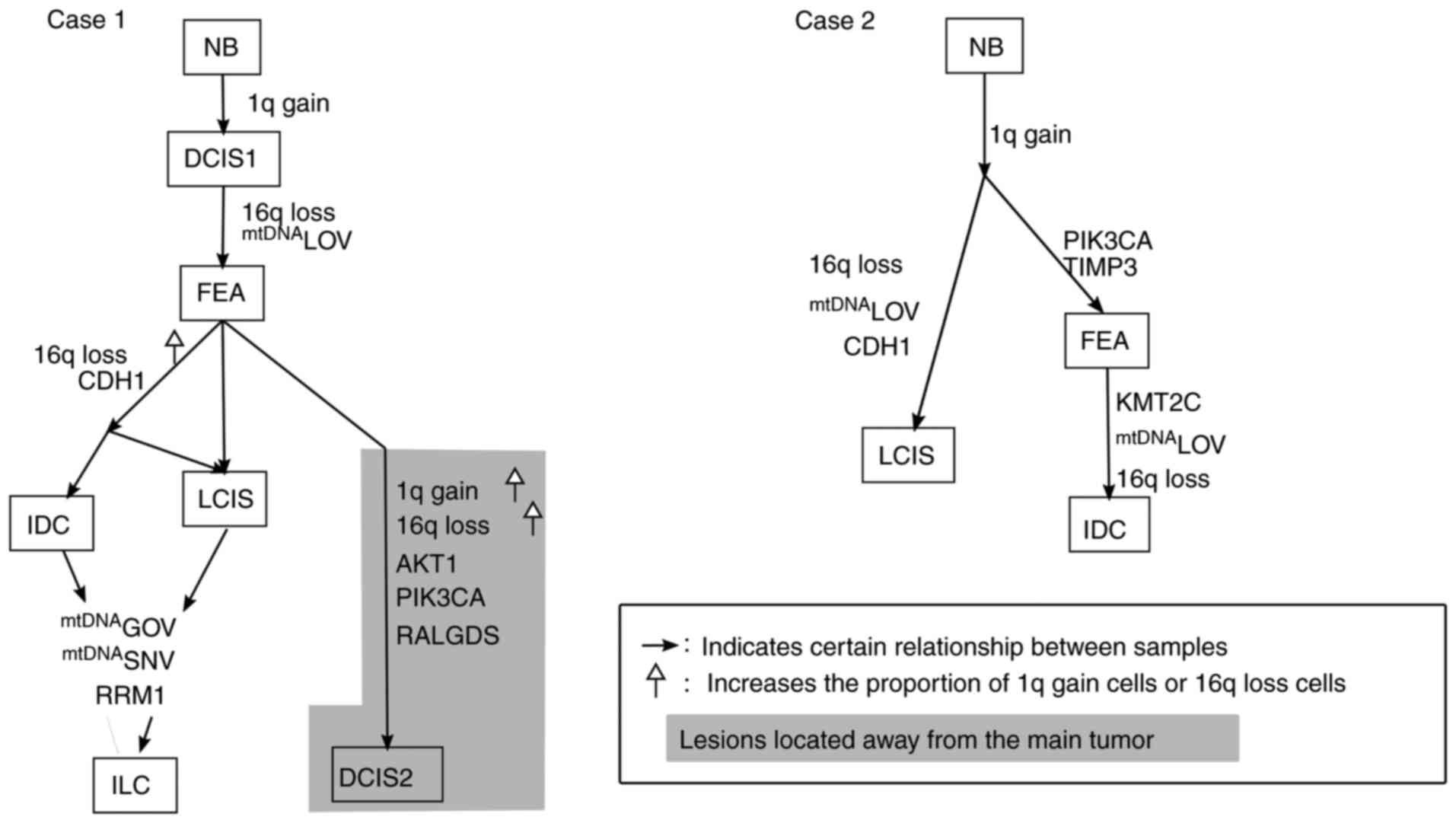|
1
|
AACR Project GENIE Consortium, . AACR
Project GENIE: Powering precision medicine through an international
consortium. Cancer Discov. 7:818–831. 2017. View Article : Google Scholar : PubMed/NCBI
|
|
2
|
Perou CM, Sørlie T, Eisen MB, van de Rijn
M, Jeffrey SS, Rees CA, Pollack JR, Ross DT, Johnsen H, Akslen LA,
et al: Molecular portraits of human breast tumours. Nature.
406:747–752. 2000. View
Article : Google Scholar : PubMed/NCBI
|
|
3
|
Sørlie T, Perou CM, Tibshirani R, Aas T,
Geisler S, Johnsen H, Hastie T, Eisen MB, van de Rijn M, Jeffrey
SS, et al: Gene expression patterns of breast carcinomas
distinguish tumor subclasses with clinical implications. Proc Natl
Acad Sci USA. 98:10869–10874. 2001. View Article : Google Scholar
|
|
4
|
Cancer Genome Atlas Network, .
Comprehensive molecular portraits of human breast tumours. Nature.
490:61–70. 2012. View Article : Google Scholar : PubMed/NCBI
|
|
5
|
Waks AG and Winer EP: Breast cancer
treatment: A Review. JAMA. 321:288–300. 2019. View Article : Google Scholar : PubMed/NCBI
|
|
6
|
Early Breast Cancer Trialists'
Collaborative Group (EBCTCG), ; Davies C, Godwin J, Gray R, Clarke
M, Cutter D, Darby S, McGale P, Pan HC, Taylor C, et al: Relevance
of breast cancer hormone receptors and other factors to the
efficacy of adjuvant tamoxifen: Patient-level meta-analysis of
randomised trials. Lancet. 378:771–784. 2011. View Article : Google Scholar : PubMed/NCBI
|
|
7
|
Slamon DJ, Clark GM, Wong SG, Levin WJ,
Ullrich A and McGuire WL: Human breast cancer: Correlation of
relapse and survival with amplification of the HER-2/neu oncogene.
Science. 235:177–182. 1987. View Article : Google Scholar : PubMed/NCBI
|
|
8
|
Cobleigh MA, Vogel CL, Tripathy D, Robert
NJ, Scholl S, Fehrenbacher L, Wolter JM, Paton V, Shak S, Lieberman
G and Slamon DJ: Multinational study of the efficacy and safety of
humanized anti-HER2 monoclonal antibody in women who have
HER2-overexpressing metastatic breast cancer that has progressed
after chemotherapy for metastatic disease. J Clin Oncol.
17:2639–2648. 1999. View Article : Google Scholar : PubMed/NCBI
|
|
9
|
Burstein HJ, Curigliano G, Loibl S, Dubsky
P, Gnant M, Poortmans P, Colleoni M, Denkert C, Piccart-Gebhart M,
Regan M, et al: Estimating the benefits of therapy for early-stage
breast cancer: The St. Gallen international consensus guidelines
for the primary therapy of early breast cancer 2019. Ann Oncol.
30:1541–1557. 2019. View Article : Google Scholar : PubMed/NCBI
|
|
10
|
Weigelt B, Geyer FC and Reis-Filho JS:
Histological types of breast cancer: How special are they? Mol
Oncol. 4:192–208. 2010. View Article : Google Scholar : PubMed/NCBI
|
|
11
|
Weigelt B, Horlings H, Kreike B, Hayes M,
Hauptmann M, Wessels L, De Jong D, Van de Vijver M, Van't Veer LJ
and Peterse J: Refinement of breast cancer classification by
molecular characterization of histological special types. J Pathol.
216:141–150. 2008. View Article : Google Scholar : PubMed/NCBI
|
|
12
|
Yates LR, Gerstung M, Knappskog S, Desmedt
C, Gundem G, Van Loo P, Aas T, Alexandrov LB, Larsimont D, Davies
H, et al: Subclonal diversification of primary breast cancer
revealed by multiregion sequencing. Nat Med. 21:751–759. 2015.
View Article : Google Scholar : PubMed/NCBI
|
|
13
|
Nik-Zainal S, Van Loo P, Wedge DC,
Alexandrov LB, Greenman CD, Lau KW, Raine K, Jones D, Marshall J,
Ramakrishna M, et al: The life history of 21 breast cancers. Cell.
149:994–1007. 2012. View Article : Google Scholar : PubMed/NCBI
|
|
14
|
Meacham CE and Morrison SJ: Tumour
heterogeneity and cancer cell plasticity. Nature. 501:328–337.
2013. View Article : Google Scholar : PubMed/NCBI
|
|
15
|
Greaves M and Maley CC: Clonal evolution
in cancer. Nature. 481:306–313. 2012. View Article : Google Scholar : PubMed/NCBI
|
|
16
|
Linder D and Gartler SM:
Glucose-6-phosphate dehydrogenase mosaicism: Utilization as a cell
marker in the study of leiomyomas. Science. 150:67–69. 1965.
View Article : Google Scholar : PubMed/NCBI
|
|
17
|
Lyon MF: Gene Action in the X-chromosome
of the Mouse (Mus musculus L.). Nature. 190:372–373. 1961.
View Article : Google Scholar : PubMed/NCBI
|
|
18
|
Wu Y, Basir Z, Kajdacsy-Balla A, Strawn E,
Macias V, Montgomery K and Guo SW: Resolution of clonal origins for
endometriotic lesions using laser capture microdissection and the
human androgen receptor (HUMARA) assay. Fertil Steril. 79 (Suppl
1):S710–S717. 2003. View Article : Google Scholar : PubMed/NCBI
|
|
19
|
Goldstein NS, Vicini FA, Hunter S, Odish
E, Forbes S and Kestin LL: Molecular clonality relationships in
initial carcinomas, ipsilateral breast failures, and distant
metastases in patients treated with breast-conserving therapy:
Evidence suggesting that some distant metastases are derived from
ipsilateral breast failures and that metastases can metastasize. Am
J Clin Pathol. 124:49–57. 2005. View Article : Google Scholar : PubMed/NCBI
|
|
20
|
Goldstein NS, Vicini FA, Hunter S, Odish
E, Forbes S, Kraus D and Kestin LL: Molecular clonality
determination of ipsilateral recurrence of invasive breast
carcinomas after breast-conserving therapy: Comparison with
clinical and biologic factors. Am J Clin Pathol. 123:679–689. 2005.
View Article : Google Scholar : PubMed/NCBI
|
|
21
|
Teixeira MR, Ribeiro FR, Torres L, Pandis
N, Andersen JA, Lothe RA and Heim S: Assessment of clonal
relationships in ipsilateral and bilateral multiple breast
carcinomas by comparative genomic hybridisation and hierarchical
clustering analysis. Br J Cancer. 91:775–782. 2004. View Article : Google Scholar : PubMed/NCBI
|
|
22
|
Masuda S, Kadowaki T, Kumaki N, Tang X,
Tokuda Y, Yoshimura S, Takekoshi S and Osamura RY: Analysis of gene
alterations of mitochondrial DNA D-loop regions to determine breast
cancer clonality. Br J Cancer. 107:2016–2023. 2012. View Article : Google Scholar : PubMed/NCBI
|
|
23
|
Lakhani SR, Rakha E and Simpson PT:
Invasive lobular carcinoma. WHO classification of tumours of the
breast. Lakhani SR, Ellis IO, Schnitt SJ, Tan PH and van de Vijver
MJ: International Agency for Research on Cancer; Lyon: 2012
|
|
24
|
Shin SJ, Desmedt C, Kristiansen G,
Reis-Filho JS and Sasano H: Invasive lobular carcinoma. Breast
Tumours. WHO Classification of Tumours Editorial Board (ed.), .
International Agency for Research on Cancer; Lyon: 2019
|
|
25
|
McCart Reed AE, Kutasovic JR, Nones K,
Saunus JM, Da Silva L, Newell F, Kazakoff S, Melville L, Jayanthan
J, Vargas AC, et al: Mixed ductal-lobular carcinomas: Evidence for
progression from ductal to lobular morphology. J Pathol.
244:460–468. 2018. View Article : Google Scholar : PubMed/NCBI
|
|
26
|
Tazaki E, Shishido-Hara Y, Mizutani N,
Nomura S, Isaka H, Ito H, Imi K, Imoto S and Kamma H:
Histopathologcial and clonal study of combined lobular and ductal
carcinoma of the breast. Pathol Int. 63:297–304. 2013. View Article : Google Scholar : PubMed/NCBI
|
|
27
|
Nakayama Y, Yamaguchi H, Einaga N and
Esumi M: Pitfalls of DNA quantification using DNA-binding
fluorescent dyes and suggested solutions. PLoS One.
11:e01505282016. View Article : Google Scholar : PubMed/NCBI
|
|
28
|
Einaga N, Yoshida A, Noda H, Suemitsu M,
Nakayama Y, Sakurada A, Kawaji Y, Yamaguchi H, Sasaki Y, Tokino T
and Esumi M: Assessment of the quality of DNA from various
formalin-fixed paraffin-embedded (FFPE) tissues and the use of this
DNA for next-generation sequencing (NGS) with no artifactual
mutation. PLoS One. 12:e01762802017. View Article : Google Scholar : PubMed/NCBI
|
|
29
|
Schmittgen TD and Livak KJ: Analyzing
real-time PCR data by the comparative C(T) method. Nature Protoc.
3:1101–1108. 2008. View Article : Google Scholar : PubMed/NCBI
|
|
30
|
Stoneking M: Hypervariable sites in the
mtDNA control region are mutational hotspots. Am J Hum Genet.
67:1029–1032. 2000. View
Article : Google Scholar : PubMed/NCBI
|
|
31
|
Nakai T, Sakurada A, Endo T, Kobayashi H,
Masuda S, Makishima M and Esumi M: Caution for simple sequence
repeat number variation in the mitochondrial DNA D-loop to
determine cancer-specific variants. Oncol Lett. 17:1883–1888.
2019.PubMed/NCBI
|
|
32
|
Rychlik W, Spencer WJ and Rhoads RE:
Optimization of the annealing temperature for DNA amplification in
vitro. Nucleic Acids Res. 18:6409–6412. 1990. View Article : Google Scholar : PubMed/NCBI
|
|
33
|
Hwang ES, DeVries S, Chew KL, Moore DH II,
Kerlikowske K, Thor A, Ljung BM and Waldman FM: Patterns of
chromosomal alterations in breast ductal carcinoma in situ. Clin
Cancer Res. 10:5160–5167. 2004. View Article : Google Scholar : PubMed/NCBI
|
|
34
|
Huiping C, Sigurgeirsdottir JR, Jonasson
JG, Eiriksdottir G, Johannsdottir JT, Egilsson V and Ingvarsson S:
Chromosome alterations and E-cadherin gene mutations in human
lobular breast cancer. Br J Cancer. 81:1103–1110. 1999. View Article : Google Scholar : PubMed/NCBI
|
|
35
|
Buerger H, Otterbach F, Simon R, Schäfer
KL, Poremba C, Diallo R, Brinkschmidt C, Dockhorn-Dworniczak B and
Boecker W: Different genetic pathways in the evolution of invasive
breast cancer are associated with distinct morphological subtypes.
J Pathol. 189:521–526. 1999. View Article : Google Scholar : PubMed/NCBI
|
|
36
|
Mohsin SK, O'Connell P, Allred DC and
Libby AL: Biomarker profile and genetic abnormalities in lobular
carcinoma in situ. Bresast Cancere Res Treat. 90:249–256. 2005.
View Article : Google Scholar : PubMed/NCBI
|
|
37
|
Weigelt B, Geyer FC, Natrajan R,
Lopez-Garcia MA, Ahmad AS, Savage K, Kreike B and Reis-Filho JS:
The molecular underpinning of lobular histological growth pattern:
A genome-wide transcriptomic analysis of invasive lobular
carcinomas and grade- and molecular subtype-matched invasive ductal
carcinomas of no special type. J Pathol. 220:45–57. 2010.
View Article : Google Scholar : PubMed/NCBI
|
|
38
|
Lopez-Garcia MA, Geyer FC, Lacroix-Triki
M, Marchio C and Reis-Filho JS: Breast cancer precursors revisited:
Molecular features and progression pathways. Histopathology.
57:171–192. 2010. View Article : Google Scholar : PubMed/NCBI
|
|
39
|
Abdel-Fatah TMA, Powe DG, Hodi Z,
Reis-Filho JS, Lee AHS and Ellis IO: Morphologic and molecular
evolutionary pathways of low nuclear grade invasive breast cancers
and their putative precursor lesions: Further evidence to support
the concept of low nuclear grade breast neoplasia family. Am J Surg
Pathol. 32:513–523. 2008. View Article : Google Scholar : PubMed/NCBI
|
|
40
|
Razavi P, Chang MT, Xu G, Bandlamudi C,
Ross DS, Vasan N, Cai Y, Bielski CM, Donoghue MT, Jonsson P, et al:
The genomic landscape of endocrine-resistant advanced breast
cancers. Cancer Cell. 34:427–438. e426. 2018. View Article : Google Scholar : PubMed/NCBI
|
|
41
|
Da Silva L, Parry S, Reid L, Keith P,
Waddell N, Kossai M, Clarke C, Lakhani SR and Simpson PT: Aberrant
expression of E-cadherin in lobular carcinomas of the breast. Am J
Surg Pathol. 32:773–783. 2008. View Article : Google Scholar : PubMed/NCBI
|















